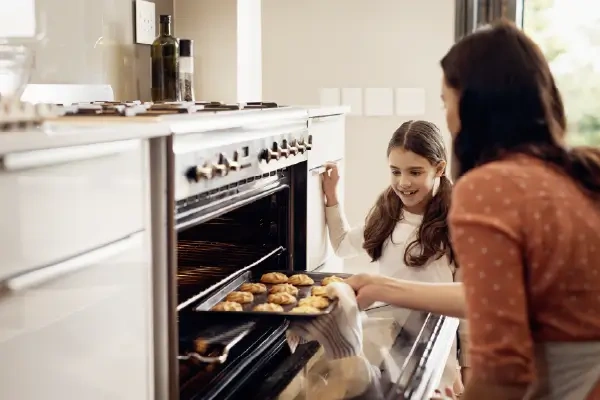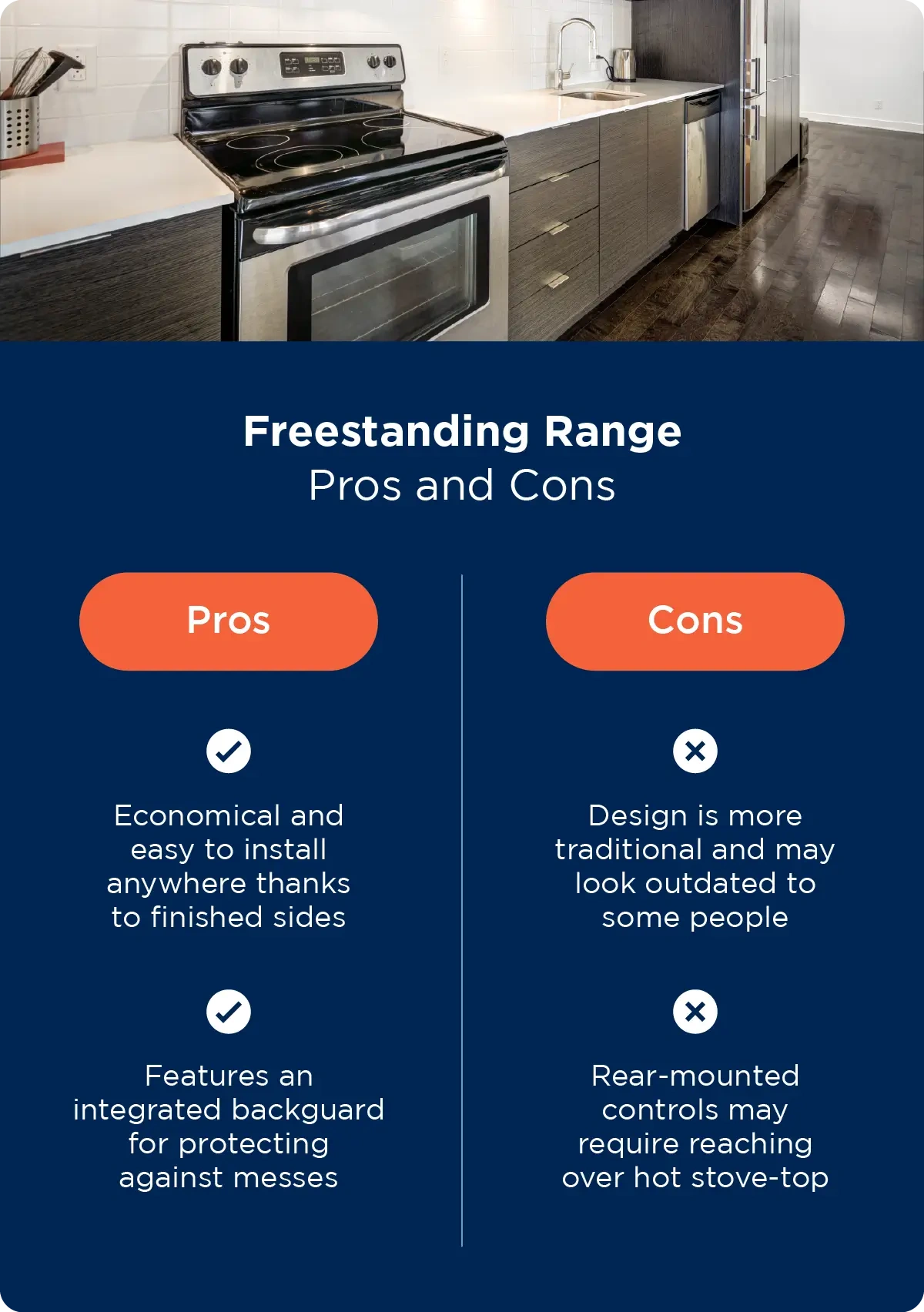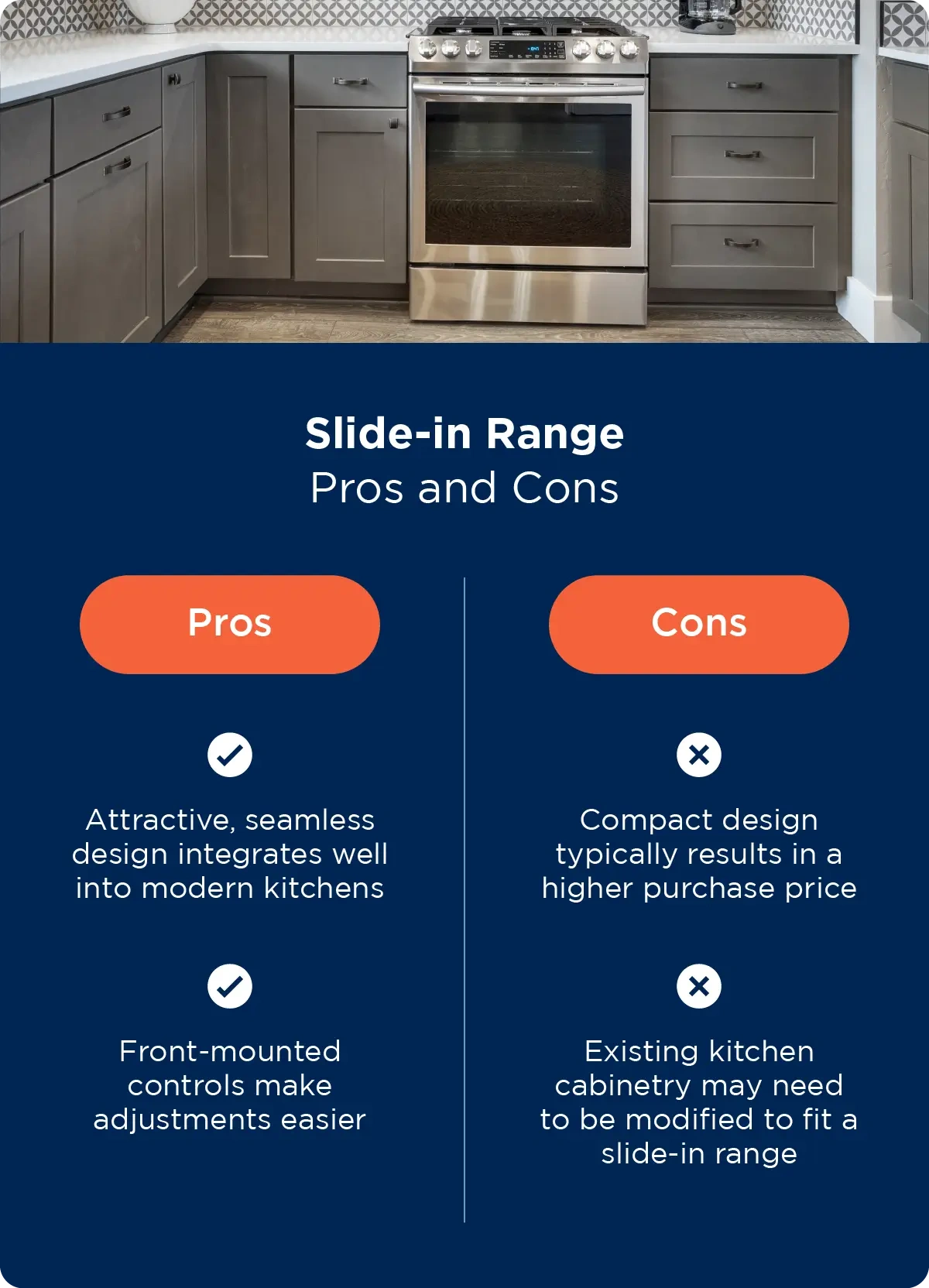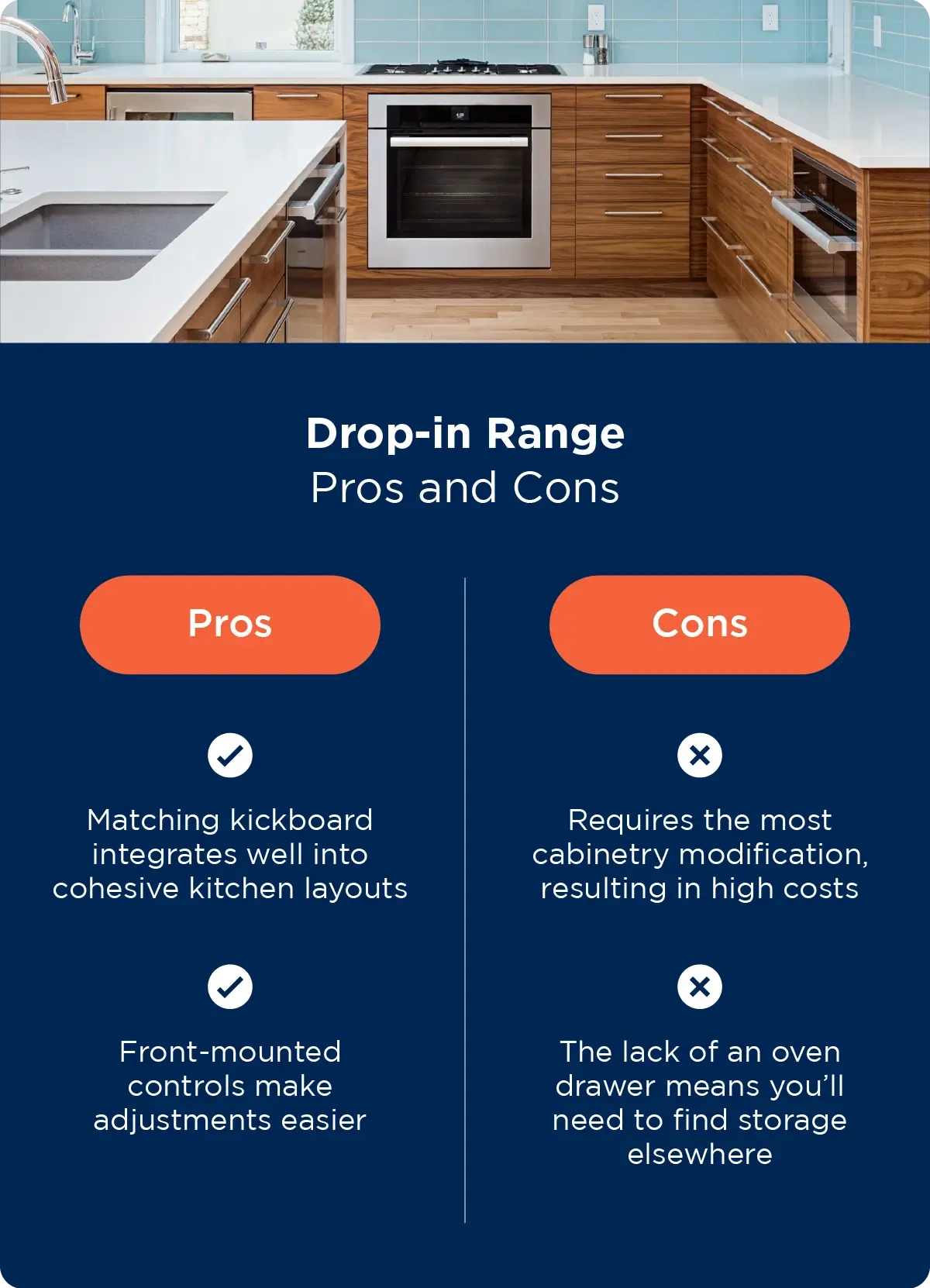Freestanding and Slide-in Range Comparison

|
Freestanding ranges feature integrated backguards and finished sides, making them suitable for placement anywhere in your kitchen. Slide-in ranges feature integrated controls at the front of the unit and may not feature finished sides, making them more suited for placement between countertops or within a kitchen island. |
While freestanding and slide-in ranges differ in installation, the choice of which option is right for you usually comes down to a matter of personal taste. After all, these major appliances will play an essential role in your kitchen for the next 16+ years. Differences in controls, features, and price will also play a part in deciding whether a freestanding vs. slide-in range best suits your home.
You can put a freestanding range nearly anywhere, thanks to their integrated backguards and finished sides. Slide-in ranges lack backguards and sometimes finished sides, making them better choices for placing between countertops. We'll examine both options and their differences to see which is best for your kitchen.
If you’re worried about the current state of your kitchen appliances, follow these essential range and stove maintenance tips from our appliance experts to prolong their lifespan.
.webp)
What’s the Difference Between a Slide-in and a Freestanding Range?
The most significant difference between freestanding and slide-in ranges is their installation methods. The backyard and finished sides allow you to place freestanding ranges nearly anywhere in a kitchen without much fuss. Slide-in ranges lack backguards and, often, finished sides, making them better choices for setting between countertops or within a kitchen island.
Slide-in ranges provide a more streamlined, modern look over their traditional freestanding counterparts due to their front-mounted controls and lack of backguards. But prepare yourself—miniaturizing the electronics that are typically found in backboards into sleek front-mounted controls tends to translate to higher purchasing prices. Freestanding ranges remain the more economical option for your kitchen.
|
Freestanding Range |
Slide-In Range |
|
|
|
|
|
|
|
|
It is important to note that slide-in and freestanding ranges can both operate using the two most common fuel sources: electricity and gas. Deciding which fuel system fits your home kitchen needs is an ideal place to start when upgrading your appliances.
What Is a Freestanding Range?

A freestanding range features finished sides and a rear backyard. Due to their design, you can easily install these ranges in most kitchen layouts, and they generally don't require special modifications to your cabinetry. Freestanding ranges work well with cabinetry only on a singular side, thanks to their finished appearance.
The backyard at the rear of a freestanding range houses the unit's electronics and controls. It also has another purpose: protecting your wall from grease and splashes — therefore, no backsplash is needed. However, it's important to note that a backguard may not work as well with a kitchen island where it may obstruct your view.
We recommend freestanding ranges for individuals seeking value and the flexibility to position this kitchen appliance wherever they want. They are also ideal for homeowners who do not want to renovate their existing kitchen cabinetry.
What Is a Slide-in Range?

Slide-in ranges drop the backyard to offer a more streamlined, modern style. Unlike freestanding ranges, slide-in ranges integrate their controls at the front of the unit, allowing for easier access while cooking. Some slide-in ranges may not offer finished sides, which makes them an ideal choice for installation between cabinetry.
A lack of a backguard makes these ranges the perfect option for installing within a kitchen island where a backguard may be unsightly. When installing a slide-in range against a wall, you'll want to include a backsplash. This will prevent grease and other cooking liquids from getting on your wall, and you’ll want to prolong the life of your kitchen appliances and walls just as equally.
Slide-in ranges offer a more integrated kitchen look, especially for those who want to place a range within their kitchen island. While integrated styling may be more appealing, be prepared to pay a higher price tag for this modern design. If you previously had a freestanding range, you’ll need to make some modifications to cabinets to accommodate the slide-in model.
What Is a Drop-in Range?

Drop-in ranges feature a similar design to slide-in ranges but do not extend to the floor. Drop-in ranges integrate exceptionally well into a kitchen, with the cabinetry extended as a kickboard for a more cohesive look. As a result, drop-in ranges require the most installation work and, thus, usually a higher overall cost. But, considering the average kitchen range lasts 16 years, the investment may be worth it.
It's essential to note the difference between a drop-in range and a drop-in stove top. A drop-in range is a complete kitchen appliance, including a stovetop and an oven. On the other hand, a drop-in stove top is a stove top that doesn’t include an oven.
As drop-in ranges typically require extra cabinetry modifications and installation costs, they are best suited for homeowners who desire well-integrated kitchen appliances. It’s important to note that choosing this option eliminates the convenient storage drawer at the base of most ovens — so your pots and pans will need to find a new home.
Mr. Appliance Offers an Expert Range of Installation
If you're deciding on a new freestanding vs. slide-in range because your existing range is giving you trouble, consider repair as an alternative. Before banishing your range to the landfill, talk to your local Mr. Appliance expert to see if repairing your kitchen range is an option that could save you money.
Mr. Appliance offers appliance repair and servicing for top brands, including Whirlpool, Maytag, Dacor, Frigidaire, GE, KitchenAid, and Thermador. And if your old range is beyond repair or it makes more sense to buy a new one, Mr. Appliance can handle all your installation needs.
Whether you need repairs, maintenance, or installation, you can rest assured knowing all our work is backed by the Neighborly Done Right Promise™.
FAQ About Freestanding and Slide-In Ranges
Does A Slide-In Range Need a Countertop Behind It?
Slide-in ranges typically require a bit of countertop behind them. Slide-in ranges will not get installed against your wall; thus, an inch or two of countertop is added to fill the gap and create a more seamless appearance.
Can You Replace A Freestanding Range With a Slide-In Range?
Yes, you can replace a freestanding range with a slide-in range, but it will likely require modifications to your existing cabinetry. Freestanding ranges are designed to be placed against walls, while slide-in ranges are not. As a result, you may need to put an inch or two of cabinetry behind the slide-in range during installation.
Can a Slide-In Range Be Freestanding?
Slide-in ranges are not designed to be freestanding and typically do not feature finished sides. As a result, you would not want to install a slide-in range in a freestanding manner — it’s best to install them with cabinets on both sides.
Why Are Slide-In Ranges More Expensive?
Slide-in ranges are more expensive due to the need to miniaturize their electric components. Engineers needed to fit the backyard controls into a more compact space at the front of the appliance. Slide-in ranges may also require minor cabinet modifications before installation.
Can a Freestanding Range Be Used As a Slide-In Range?
If you previously had a slide-in range, you can replace it with a freestanding model. However, as slide-in ranges are designed to have a bit of cabinetry at the back, you may need to make minor modifications to your kitchen to accommodate this design. A freestanding range, once installed, sits flush against your kitchen wall.
 Click to call
Click to call



